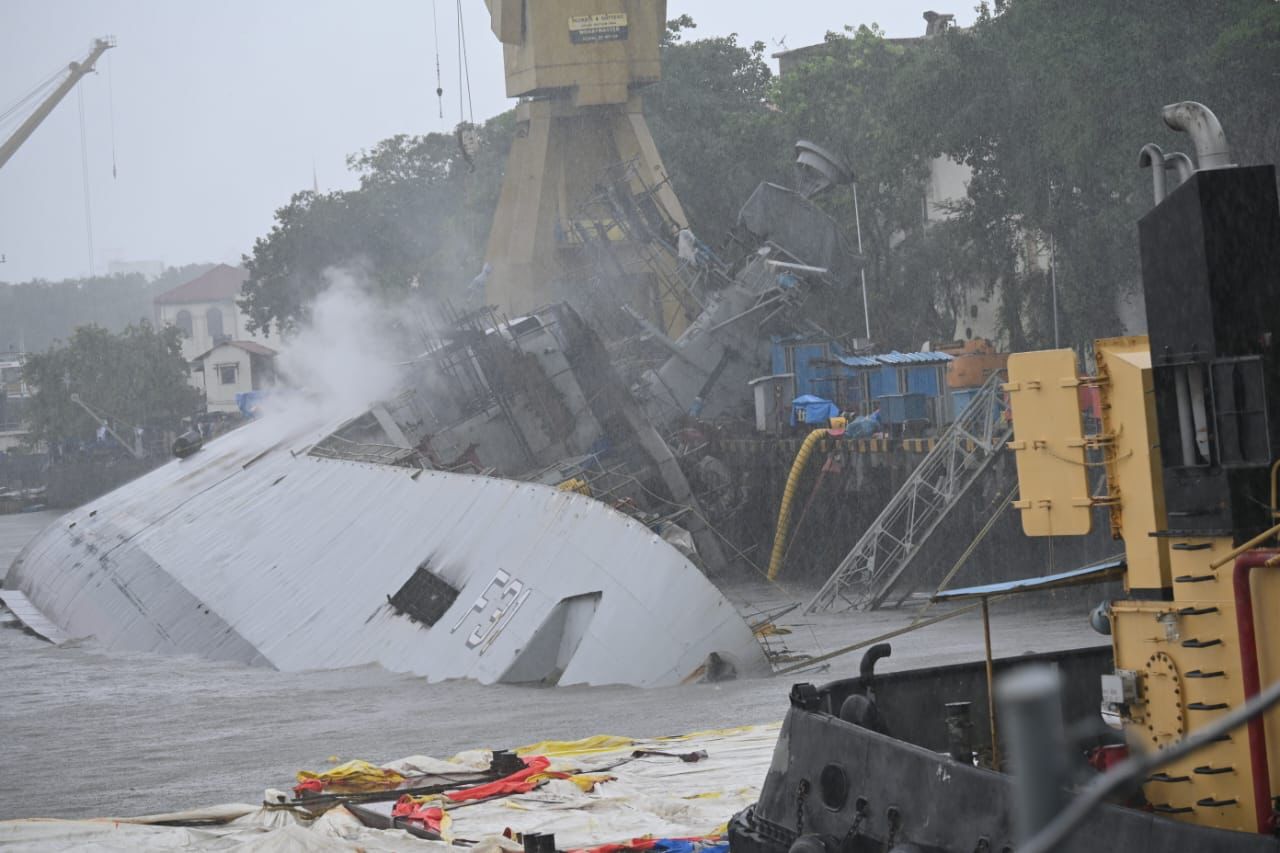July 21 marked a tragic day for the Indian Navy when a devastating fire erupted on the INS Brahmaputra, inflicting significant damage and causing the vessel to list.
The fire reportedly broke out when the INS Brahmaputra was undergoing refit and maintenance work at a dockyard in Mumbai, Maharashtra. Making matters worse, a junior sailor from the crew has gone missing after the warship caught fire. A search is on at the time of writing this report.
A set of photos appeared on social media, showing what was “left of the ship” after the fire severely damaged it. Officials cited by Indian media verified that the photographs, which appeared on social media and TV channels, were of the damaged frigate lying flat on its side at the berth.
The Indian navy said on July 23 that the ship suffered serious “listing” to the port side and that all attempts to turn it around failed. When a vessel absorbs water, it “lists” or tilts to one side. An inquiry has since been launched into the incident, and Navy Chief Admiral Dinesh K. Tripathi apprised the Indian Defence Minister Rajnath Singh about the accident.
Several Indian media reports cited anonymous sources to claim that the lead warship of the Brahmaputra class, a 3,850-tonne multirole frigate, had sustained severe damage and was expected to be out of service for several months.
Several military observers expressed a similar opinion after examining the photos of the vessel. Some observers said the warship’s critical equipment was likely to have been damaged.
According to a statement published by the Indian Navy, the ship’s crew contained the fire with the help of firefighters from the naval dockyard and other nearby ships.
The statement read, “Subsequently, in the afternoon, the ship experienced severe listing to one side (port side). Despite all efforts, the ship could not be brought to the upright position. The ship continued to list further alongside her berth and is presently resting on one side. All personnel have been accounted for except one junior sailor, for whom the search is in progress.”
INS Brahmaputra: What Might Have Happened
Commander Ashok Bijalwan, a retired Indian submariner, examined the incident through the lens of a firefighting and damage expert.
He explained, “A ship undergoing refit is at a greater risk against fire as many of its systems are under repair and refit. The situation is complicated by ‘Hot Work’ (welding/ gas cutting) at multiple locations on board during this period. It is common for fires to take place on ships, especially during refit.

However, when dealt with alacrity and with the right type of first-aid (portable) fire extinguisher, fires can be brought under control with ease. The problem arises when either of the two conditions is not met. Once the fire attains a bigger proportion, the next step is to fight it with water (or seawater, to be specific, as it is abundantly available all around).”
He then explained that much of the water sprayed on the fire ended up falling on the deck, increasing the ship’s weight and impairing its stability. The excess water must be pumped out and tossed overboard to keep the ship stable.
The ship’s stability will undoubtedly be impacted if its pumping-out capacity is less than the amount of water being poured into it (either by design or as a result of systems undergoing renovations). Depending on which side the major share of the water is being drained to, the ship may start to develop a list or heel.
In more technical terms and by incorporating some fundamentals of physics, Commander Bijalwan wrote, “When the ship is upright, the center of gravity and center of buoyancy is on the centreline (with CoG below the CoB) and oppose each other. As more water accumulates, the top weight increases, causing the CoG to move upwards while the increase in list moves the CoB outwards and lower, creating a righting arm that accentuates the list. Once the CoG crosses the level of CoB and moves above it, the ship cannot maintain its buoyancy any longer and capsizes or topples over.”
The retired officer said the above scenario appears to have happened in this particular instance. The accompanying video showed the fire raging in the superstructure, indicating that the water was contributing to the top weight.
When asked about another vessel, INS Betwa, which also caught fire in 2016, Commander Bijalwan said, “INS Betwa capsized under completely different circumstances, and there was no pattern of accidents to observe.”
SHOCKING VISUALS 🚨🚨
■INS Brahmaputra,Indian Active War Ship Sinking in peace time is big big blow for Indian Navy.
■This is 3rd loss of major Indian naval asset at Mumbai Naval Dockyard in last 11 years.
▪︎2013-INS SindhuRakshak
▪︎2016-INS betwaWho is accountable? pic.twitter.com/ulqSi2zLAo
— Manu🇮🇳🇮🇳 (@mshahi0024) July 23, 2024
However, speaking to the EurAsian Times, Commander Bijalwan added, “All naval personnel, irrespective of rank, go through an NBCD course (Nuclear, Biological, Chemical Defence, Firefighting and Damage Control are essential aspects for a Navy) where they are trained extensively on Firefighting and Damage Control before they are posted on ships for watchkeeping duties. So, it would be incorrect to say that the crew didn’t know what to do.”
Another official who did not want to be named told EurAsian Times that it is not uncommon for ships undergoing refits at dockyards to catch fire. In some circumstances, however, the fire could turn lethal and cause extensive damage to the vessel.
While the investigation is ongoing, a few military analysts wrote on social media that the chances of salvaging currently seem unclear. Some went on to say that the INS Brahmaputra seems to have bitten the dust, and they expressed alarm that the Indian Navy was shockingly losing ships in peacetime.
It is the third peacetime loss after INS Betwa (2016) and INS Sindhurakshak (2013).
- Contact the author at sakshi.tiwari9555 (at) gmail.com
- Follow EurAsian Times on Google News




